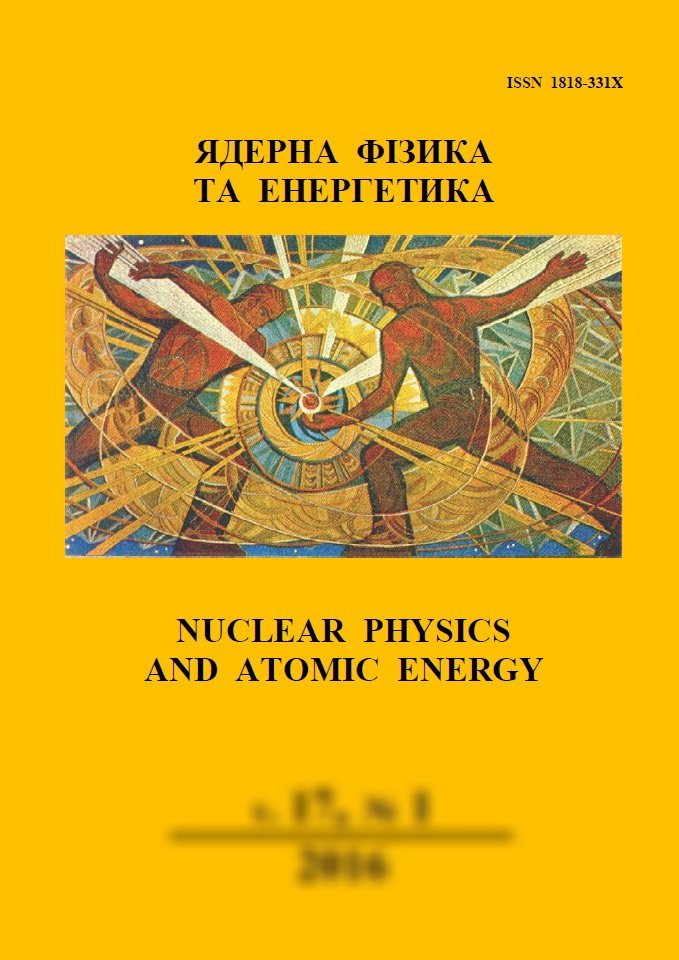 |
Ядерна фізика та енергетика
Nuclear Physics and Atomic Energy
ISSN:
1818-331X (Print), 2074-0565 (Online)
Publisher:
Institute for Nuclear Research of the National Academy of Sciences of Ukraine
Languages:
Ukrainian, English, Russian
Periodicity:
4 times per year
Open access peer reviewed journal
|
Nucl. Phys. At. Energy 2020, volume 21, issue 1, pages 5-12.
Section: Nuclear Physics.
Received: 06.11.2019; Accepted: 19.03.2020; Published online: 14.05.2020.
 Full text (ru)
Full text (ru)
https://doi.org/10.15407/jnpae2020.01.005
Averaged overall atomic electrons probability of positrons annihilation at β+-decay
S. N. Fedotkin*
Institute for Nuclear Research, National Academy of Sciences of Ukraine, Kyiv, Ukraine
*Corresponding author. E-mail address:
sfedot@kinr.kiev.ua
Abstract:
An approximate method for calculating the probability of single-photon annihilation of a positron with an atomic electron at the β+-decay averaged over all electrons of the daughter atom is proposed. The electrons are described in the framework of the Thomas - Fermi statistical model. This approximation makes it easy the calculation of the average probabilities of various processes involving all the electrons of the atom. The total probability of single-photon annihilation is calculated using an approximate analytical expression for the atomic electrons’ density. A good agreement between the probabilities calculated in the proposed approach and the estimates obtained in the framework of quantum mechanics was obtained.
Keywords:
annihilation, β+-decay, atomic shell, K-electron, Thomas - Fermi approximation.
References:
1. W.R. Johnson, D.J. Buss, C.O. Carrol. Single-Quantum Annihilation of Positrons. Phys. Rev. 135(5) (1964) A1232.
https://doi.org/10.1103/PhysRev.135.A1232
2. S. Shimizu, T. Mukoyama, Y. Nakayama. Radiationless Annihilation of Positron in Lead. Phys. Rev. 173(2) (1968) 405.
https://doi.org/10.1103/PhysRev.173.405
3. R. Present, S. Chen. Nuclear Disintegration by Positron-K Electron Annihilation. Phys. Rev. 85 (1952) 447.
https://doi.org/10.1103/PhysRev.85.447
4. T. Mukoyama, S. Shimizu. Nuclear excitation by positron annihilation. Phys. Rev. C 5 (1972) 95.
https://doi.org/10.1103/PhysRevC.5.95
5. I.N. Vishnevskiy et al. Nuclear excitation under the influence of photonless positron annihilation. Pis'ma ZHETF (JETP Letters) 30 (1979) 394. (Rus)
http://www.jetpletters.ac.ru/ps/437/article_6913.shtml
6. D.P. Grechukhin, A.A. Soldatov. Excitation of a nucleus upon annihilation of positrons on the K-shell of heavy atoms. ZHETF (JETP) 74 (1978) 13. (Rus)
http://www.jetp.ac.ru/cgi-bin/e/index/r/74/1/p13?a=list
7. G.P. Borozenets, I.N. Vishnevskiy, V.A. Zheltonozhskiy. Excitation of the nucleus upon annihilation of positrons in the process of β+-decay. Yadernaya Fizika 43(1) (1986) 14. (Rus)
8. V.M. Kolomiyets, O.G. Puninskiy, S.N. Fedotkin. Excitation of a nucleus upon annihilation of a positron with a K-electron in the process of β+-decay. Izvestiya AN SSSR. Ser. Fiz. 52(1) (1988) 12. (Rus)
9. P. Morrison, I.I. Schiff. Radiative K capture. Phys. Rev. 58(1) (1940) 24.
https://doi.org/10.1103/PhysRev.58.24
10. R.J. Glauber, P.C. Martin. Radiative Capture of Orbital Electrons. Phys. Rev. 104(1) (1956) 158.
https://doi.org/10.1103/PhysRev.104.158
11. P.C. Martin, R.J. Glauber. Relativistic Theory of Radiative Orbital Electron Capture. Phys. Rev. 109(4) (1958) 1307.
https://doi.org/10.1103/PhysRev.109.1307
12. S.N. Fedotkin. Atomic ionization at annihilation of positrons emitted at β+-decay. Yaderna Fizyka ta Energetyka (Nucl. Phys. At. Energy) 12(4) (2011) 335. (Rus)
https://jnpae.kinr.kyiv.ua/12.4/Articles_PDF/jnpae-2011-12-0335-Fedotkin.pdf
13. S.N. Fedotkin. The effect of the nuclear Coulomb field on atomic ionization at positron-electron annihilation in β+ decay. Eur. Phys. J. Conf. Ser. 93 (2015) 01046.
https://doi.org/10.1051/epjconf/20159301046
14. C.F. Fischer. The Hartree - Fock Method for Atoms (N.Y., London: John Wiley & Sons, 1977) 308 p.
Google books
15. Electronic and Atomic Collision. Ed. by G. Watel, P.G. Burke (North-Holland, Amsterdam, 1978) 747 p.
Google books
16. K. Smith, R.J.W. Henry, P.G. Burke. Scattering of Electrons by Atomic Systems with Configurations 2pq and 3pq. Phys. Rev. 147 (1966) 21.
https://doi.org/10.1103/PhysRev.147.21
17. L.H. Thomas. The calculation of atomic fields. Math. Proc. Camb. Phil. Soc. 23(5) (1927) 542.
https://doi.org/10.1017/S0305004100011683
18. E. Fermi. Statistical method to determine some properties of atoms. Rendiconti Lincei 6 (1927) 602;
http://ricerca.mat.uniroma3.it/ipparco/pagine/deposito/2011/TF.pdf
E. Fermi. Eine statistische Methode zur Bestimmung einiger Eigenschaften des Atoms und ihre Anwendung auf die Theorie des periodischen Systems der Elemente. Z. Phys. 48(1-2) (1928) 73.
https://link.springer.com/article/10.1007/BF01351576
19. P. Gombas. Die Statistische Theorie des Atoms und ihre Anwendungen (Wien: Springer-Verlag, 1949) 399 p.
https://doi.org/10.1007/978-3-7091-2100-9
20. Theory of the Inhomogeneous Electron Gas. Ed. by S. Lundqvist, N.H. March (New York and London, Plenum Press, 1983) 394 p.
Google books
21. M. Brack, R.K. Bhaduri. Semiclassical Physics (USA, Westview Press, Boulder, 2003) 458 p.
Google books
22. S. Seriy. Modern Ab-Initio Calculations on Modified Tomas-Fermi-Dirac Theory. Open Journal of Modelling and Simulation 3(3) (2015) 57362.
https://doi.org/10.4236/ojmsi.2015.33010
23. V.Ya. Karpov, G.V. Shpatakovskaya. Inclusion of the Discreteness of the Electronic Spectrum in the Statistical Model of Free Ions. JETP Letters 98 (2013) 348.
https://doi.org/10.1134/S0021364013190065
24. G.V. Shpatakovskaya. Semiclassical model of the structure of matter. Uspekhi Fizicheskikh Nauk (Physics-Uspekhi) 55(5) (2012) 429.
https://doi.org/10.3367/UFNr.0182.201205a.0457
25. T. Tietz. Simple Analytical Eigenfunctions of Electrons in Thomas - Fermi Atoms. Zs. Naturfosch. 23a (1968) 191.
https://doi.org/10.1515/zna-1968-0126
26. S.N. Fedotkin. Annihilation of positrons, emitted at β+-decay with electrons of the daughter's atom. Yaderna Fizyka ta Energetyka (Nucl. Phys. At. Energy) 11(3) (2010) 233. (Rus)
https://jnpae.kinr.kyiv.ua/11.3/Articles_PDF/jnpae-2010-11-0233-Fedotkin.pdf
27. S.N. Fedotkin. Cross-section of the photoeffect averaged over the atomic electrons. Yaderna Fizyka ta Energetyka (Nucl. Phys. At. Energy) 17(3) (2016) 226. (Rus)
https://doi.org/10.15407/jnpae2016.03.226
28. J. Lindhard. Influence of crystal lattice on motion of energetic charged particles Mat. Fys. Medd. Dan. Vid. Selsk. 34(14) (1965) 64 p.
http://gymarkiv.sdu.dk/MFM/kdvs/mfm%2030-39/mfm-34-14.pdf
29. O.B. Firsov. The simplified Thomas-Fermi-Dirac equation and approximation of its calculation for an atomic potential. Rad. Eff. 61(1-2) (1982) 73.
https://doi.org/10.1080/00337578208225735
30. E. Fermi. Le orbite ∞ s degli elementi. Mem. Accad. d’Italia 6(1) (1934) 119.
31. The decay schemes of radionuclides. Energy and radiation intensity. Part 1 - 2 (Moskva, 1987). (Rus)
32. D.A. Kirzhnits, Yu.Ye. Lozovik, G.V. Shpatakovskaya. Statistical model of a substance. Uspekhi Fizicheskikh Nauk 117(01) (1975) 3. (Rus)
https://doi.org/10.3367/UFNr.0117.197509a.0003
